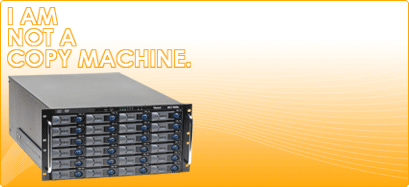Deduplication prevents businesses from repeating themselves
Clever marketing from Overland Storage: contrasting their de-duplication solution with a copy machine. For me it brings home the essence of what de-dupe is all about.

As I posted yesterday, a major headache and expense for business data protection today is redundancy, meaning copying the same files over and over and over again. Deduplication is one of those technologies whose value is pretty easy to explain: it makes only one copy of everything, reducing the capacity required by 10 to 20X.
Management is limited, data is not
Rather than reduce capacity requirements, that frees up more data to be created, used, saved, distributed. Storage demand is not limited by the amount of data created, but by the ability of consumers and businesses to effectively manage it.
Case in point: according to EMC and IDC, 2007 was the first year that the data generated and replicated in the world exceeded the storage available to keep it.
Less data leads to more storage
I’ll say that again: Deduplication leads to more storage. Agree or disagree? Tell me why.





